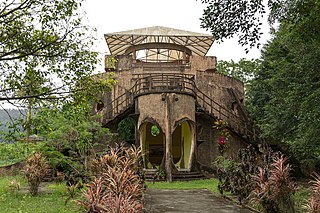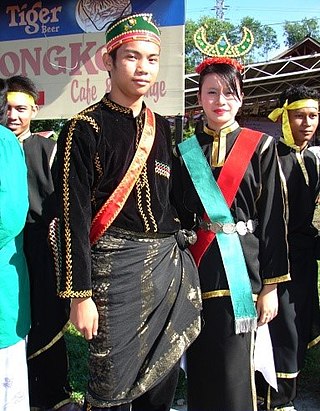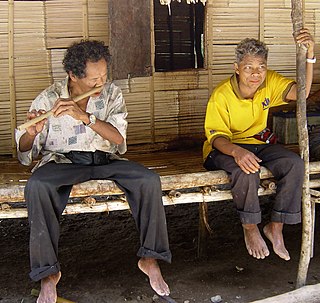
Dusun is the collective name of an indigenous ethnic group to the Malaysian state of Sabah of North Borneo. Collectively, they form the largest ethnic group in Sabah. The Dusun people have been internationally recognised as indigenous to Borneo since 2004 as per the United Nations Educational, Scientific and Cultural Organization (UNESCO).

The Kadazans are an ethnic group indigenous to the state of Sabah in Malaysia. They are found mainly in Penampang on the west coast of Sabah, the surrounding locales, and various locations in the interior.

The Kwijau or Kuijau are an indigenous ethnic group residing in Sabah, eastern Malaysia on the island of Borneo. The Kwijau tribe claim descent from the Nunuk Ragang settlers who intermarried and assimilated with the native Muruts. They reside in the Keningau district of the Interior Division within a 12-mile radius to the west and north of Keningau town centre. Their population was estimated at 7,910 in the year 2000. They are considered a sub-group of the Kadazan-Dusun, as their language is on the Dusunic branch of the Austronesian language family. About 20% of the population embrace the Christian faith in denominations of evangelical Christianity and Roman Catholicism with large significant Muslim minorities, the remainder are animist practicing the ancient belief system called Momolianism. They are known for performing the Magunatip, an east Malaysian dance very strongly influenced by the Philippine tinikling. Performed by the young men and women, the dance involves jumping steps that manoeuvre the dancer's feet in and out, so as not to get their feet trapped by 2 moving bamboo poles that are held by another pair of dancers, who beat the poles together and over a shorter length of wood or bamboo, creating an interesting rhythm.

The Lotud people are an indigenous ethnic group residing in Sabah, eastern Malaysia on the island of Borneo. They reside mainly in the Tuaran district and also a portion of this tribe's population also reside in the village of Kampung Sukoli located in the Telipok suburban township of Kota Kinabalu city, all located in the West Coast Division of Sabah. Their population was estimated at 5,000 in the year 1985 but now believed to be more than 20,000. They are a sub-ethnic group of the Dusunic group, now also known as Kadazan-Dusun.
The Kimaragang or Maragang people are an indigenous ethnic group residing in Sabah, eastern Malaysia on the island of Borneo. They reside in the Kota Marudu and Pitas districts of Kudat Division. Their population was estimated at 10,000 in the year 1987. They are considered a sub-group of the Kadazan-Dusun, as their language belongs to the Dusunic branch of the Austronesian language family. They are primarily farmers, raising paddy rice, cocoa, and cash crops.
The Rumanau are an indigenous ethnic group residing in Sabah, eastern Malaysia on the island of Borneo. They are known as the Lobu in the Keningau District near Lanas, and the Rumanau in the Masaum, Mangkawagu, Minusu areas of the Kinabatangan District along the Kinabatangan River, in Sandakan Division. Their population was estimated at 2,800 in the year 1991. They are a sub-group of the Kadazan-Dusun, although their language belongs to the Paitanic branch of the Austronesian language family.
The Mangka'ak are an indigenous ethnic group residing in Sabah, eastern Malaysia on the island of Borneo. They primarily reside in the Sandakan, Labuk-Sugut, and Kinabatangan districts in northeastern Sabah. The population of Mangka'ak was estimated at 20,583 in the year 2000. They are a sub-group of the Kadazan-Dusun, and their language belongs to the Dusunic branch of the Austronesian language family. The language is threatened with extinction, as most of the current generation use standard Malay in everyday speech.

Kadazan-Dusun are the largest ethnic group in Sabah, Malaysia, an amalgamation of the closely related indigenous Kadazan and Dusun peoples. They are also known as Mamasok Sabah, meaning "indigenous people of Sabah". Kadazan-Dusun tradition holds that they are the descendants of Nunuk Ragang. Kadazan-Dusun is recognised as an indigenous nation of Borneo with documented heritage by the United Nations Educational, Scientific and Cultural Organization (UNESCO) since 2004. Kadazan-Dusun is part of bumiputera group in Malaysia and has special rights concerning land, rivers, education and maintaining their own customs.

Nunuk Ragang is a site traditionally considered as the location of the original home of the ancestors of the Kadazan-Dusun natives who inhabit most of northern Borneo. The site, nearby a village named Tampias, is located at the intersection of the left and right branches of the Liwagu River to the east of Ranau and Tambunan in Sabah. The two river branches joined up to flow into the Labuk river and drain out into the Sulu Sea. At the site, and under a giant banyan tree, a settlement referred to as Nunuk Ragang was founded. The giant banyan tree was said to be able to give shade to a longhouse sheltering 10 families in it. The legend about Nunuk Ragang had been passed down via oral traditions to the younger generations. No archaeological dig has been carried out to establish the veracity of the legend.

Menggatal or Manggatal is a Malaysian town and suburb of Kota Kinabalu District on the west coast of Sabah. It is an outskirt of the state capital, Kota Kinabalu, and is under the jurisdiction of Kota Kinabalu City Hall. It is located along Jalan Tuaran, which is the main road leading north from Kota Kinabalu city centre.

Bisaya is an indigenous people from the northwest coast of East Malaysia on the island of Borneo. Their population is concentrated around Beaufort as well as Kuala Penyu districts of southern Sabah, Labuan Federal Territory and in Limbang District, Sarawak. The Bisaya tribe has many similarities with the Dusun Tatana tribe, especially in terms of language. It is evident that some of their dialogical language conversations are almost identical if they have a dialogue with each other. Nowadays the Bisaya living in Sabah are Muslims, while the Bisaya living in Sarawak are mostly Christians. In Brunei, they are referred as Dusun, Jati Dusun and Bisaya. The Bisaya is closely related, linguistically, with the Tatana Dusun of Kuala Penyu, Sabah.
Coastal Kadazan, also known as Dusun Tangara, is a dialect of the Central Dusun as well as a minority language primarily spoken in Sabah, Malaysia. It is the primary dialect spoken by the Kadazan people in the west coast of Sabah especially in the districts of Penampang, Papar and Membakut.
Central Dusun, also known as Bunduliwan, is an Austronesian language and one of the more widespread languages spoken by the Dusun peoples of Sabah, Malaysia.
The Dusunic languages are a group of languages spoken by the Bisaya and Dusun, and related peoples in the Malaysian province of Sabah on Borneo.

The Orang Asal are the indigenous peoples of Malaysia. The term is Malay for "Original People", used to refer to the aboriginals of Sabah, Sarawak, and Peninsular Malaysia. These groups are given the Bumiputera status in Malaysia.
Kimaragang (Marigang), Tobilung, and Rungus are varieties of a single Austronesian language of Sabah, Malaysia. The three varieties share moderate mutual intelligibility. Children are not learning it well in some areas.

Sabah is the third most populous state in Malaysia, with a population of 3,418,785 according to the 2020 Malaysian census. It also has the highest non-citizen population, at 810,443. Although Malaysia is one of the least densely populated countries in Asia, Sabah is particularly sparsely populated. Most of the population is concentrated along coastal areas, with towns and urban centers seeing the most population growth.

The Kudat District is an administrative district in the Malaysian state of Sabah, part of the Kudat Division which includes the districts of Kota Marudu, Kudat and Pitas. The capital of the district is in Kudat Town.

The Beluran District is an administrative district in the Malaysian state of Sabah, part of the Sandakan Division which includes the districts of Beluran, Kinabatangan, Sandakan, Telupid and Tongod. The capital of the district is in Beluran Town.

Tenghilan is a small town and mukim under the administration of the Tamparuli minor district office. It is located in the Tuaran District of the West Coast Division of Sabah, Malaysia. The Tenghilan area is centered around a small town of the same name located near the road that connects Kota Kinabalu and Kota Belud. In 2010, its population was estimated at 203 inhabitants, mostly of Kadazan-Dusun origin. The town, which covers about 400 hectares of land, is located about 17 km northeast of Tuaran, and 25 km southwest of Kota Belud.












